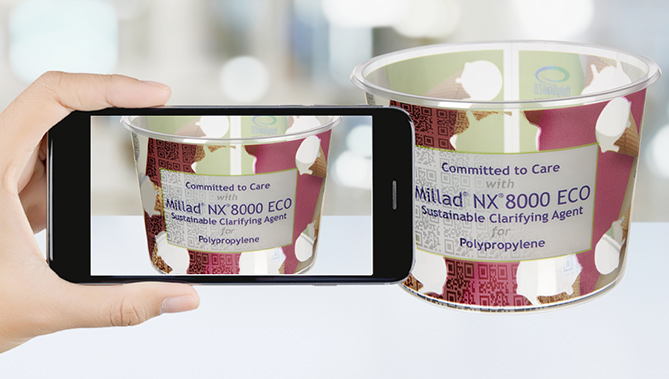HolyGrail 2.0 and Millad® NX® 8000 – towards a truly circular economy
June 21, 2021 by Paul Kearns and Zach AdamsMilliken is a proud member of the Digital Watermarks Project, a large-scale initiative on the viability of digital watermarking technologies for the accurate sorting of packaging at scale.
Its second phase, HolyGrail 2.0, will validate the concept and the technology on a semi-industrial scale by testing sorting efficiencies, consumer engagement, and distribution tracking.
This leading-edge work aligns with Milliken’s ambitious vision of a circular future, along with solutions like our Millad® NX® 8000 for polypropylene (PP), one of our next-generation additives that can contribute to this goal.
PP for recycling
Polypropylene has become a frontrunner in sustainable packaging thanks to its low carbon footprint, light weight, and recyclability. PP consumes the least amount of energy and water during production and produces the lowest CO2 emissions when compared to other transparent plastics in packaging. It also offers heat resistance, making it suitable for microwaveable food packaging.
Millad NX 8000 delivers crystal clear, glass like clarity, while extending sustainability and productivity in injection molding processes, making clarified polypropylene a viable alternative to glass, PC, PET, PVC and PS. It is recognized by the US Association of Plastic Recyclers, and RecyClass in Europe, and parts produced with Millad NX 8000 are eligible for UL Environment validation.
Interactive IML packaging: futureproof and fully recyclable
In-mold labels (IML) are a great match for Millad NX 8000 containers, as together, polypropylene IML decoration and container form mono-material packaging that is easy-to-recycle. Milliken already works in partnership with the Belgian based in-mold labelling specialist, MCC Verstraete, to create next-generation packaging.
Now, as part of HolyGrail 2.0, Interactive IML labels by MCC Verstraete are enhanced with a digital watermark, making the final packaging intelligent and futureproof. The digital watermark is a Digimarc Barcode imperceptible to the human eye but detectable with a camera for computing devices. It’s a mobile app, available on both iOS and Android, that scans digital barcodes.

It has huge potential in different stages of the packaging journey, from manufacturing and consumer engagement to sorting and recycling. As part of HolyGrail2.0, Interactive IML adds a ‘digital recycling passport’ that explains on details such as how and where the packaging was made, or, for example, whether it was used for food or not.
This technology means that waste management systems can sort waste more efficiently, leading to better waste streams and far more recycling and this turns full circle, leading us back to our ambitions for HolyGrail 2.0 and the drive for a truly circular economy.
To find out more about the Digital Watermarks Project visit chemical.milliken.com/news/milliken-to-join-the-digital-watermark-project.
To find out more about HolyGrail 2.0 visit www.aim.be/digital-watermarks.
To find out more about Milliken’s sustainability and CSR initiatives visit milliken.com/sustainability.
To find out more about Millad NX 8000 visit chemical.milliken.com/products/millad-nx-8000.
To find out more about MCC Verstraete visit www.verstraete.mcclabel.com.
